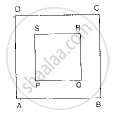Advertisements
Advertisements
प्रश्न
A bag contains 3 red balls and 5 black balls. A ball is draw at random from the bag. What is the probability that the ball drawn is red?
उत्तर
: A bag contains 3 red and 5 black balls and a ball is drawn at random from the bag
TO FIND: Probability of getting a
red ball
not red ball
Total number of balls `3+5=8`
We know that PROBABILITY =`"Number of favourable event"/"Total number of event"'`
Hence probability of getting red ball is `3/8`
APPEARS IN
संबंधित प्रश्न
Find the class mark of the classes 20-30 and 30-40.
The probability that a number selected at random from the numbers 1, 2, 3, ..., 15 is a multiple of 4, is
`(A)4/15`
`(B)2/15`
`(C)1/5`
`(D)1/3`
Two different dice are tossed together. Find the probability :
1) of getting a doublet
2) of getting a sum 10, of the numbers on the two dice.
In the given figure, a square dart board is shown. The length of a side of the larger square is 1.5 times the length of a side of the smaller square. If a dart is thrown and lands on the larger square. What is the probability that it will land in the interior of the smaller square?

A bag contains cards numbered from 1 to 49. A card is drawn from the bag at random, after mixing the cards thoroughly. Find the probability that the number on the drawn card is an even prime number.
Two dice are thrown together. The probability of getting the same number on both dice is.
A card is drawn at random from a well shuffled pack of 52 playing cards.
Find the probability that the card drawn is a spade.
In a bag there are 44 identical cards with figure of circle or square on them. There are 24 circles, of which 9 are blue and rest are green and 20 squares of which 11 are blue and rest are green. One card is drawn from the bag at random. Find the probability that it has the figure of green square.
A die is thrown once. What is the probability of getting a prime number?
It is known that a box of 200 electric bulbs contains 16 defective bulbs. One bulb is taken out at random from the box. What is the probability that the bulb drawn is defective.
A bag contains 4 white balls, 5 red balls, 2 black balls and 4 green balls. A ball is drawn at random from the bag. Find the probability that it is neither red nor green.
A card is drawn at random from a well-shuffled pack of 52 cards. Find the probability of getting a queen or a jack.
A card is drawn from a well-shuffled pack of 52 cards. Find the probability of getting a red face card.
A box contains cards bearing numbers 6 to 70. If one card is drawn at random from the box, find the probability that it bears a composite number between 50 and 70.
A box contains a certain number of balls. On each of 60% balls, letter A is marked. On each of 30% balls, letter B is marked and on each of remaining balls, letter C is marked. A ball is drawn from the box at random. Find the probability that the ball drawn is:
- marked C
- A or B
- neither B nor C
In a certain race, there are three boys X,Y, Z. The winning probability of X is twice than Y and the winning probability of Y is twice than Z. If P(X) + P(Y) + P(Z) = 1, then find the winning probability of each girl.
In a certain race there are three boys A, B, C. The winning probability of A is twice than B and the winning probability of B is twice than C. If P(A) + P(B) + P(C) = 1, then find the probabilities of their winning.
Three different coins are tossed simultaneously. Find the probability of getting exactly one head.
A bag contains 3 white, 5 black, and 2 red balls, all of the same shape and size. A ball is drawn from the bag without looking into it, find the probability that the ball drawn is a white ball.
I toss three coins together. The possible outcomes are no heads, 1 head, 2 heads and 3 heads. So, I say that probability of no heads is `1/4`. What is wrong with this conclusion?
